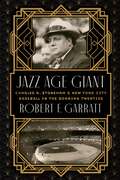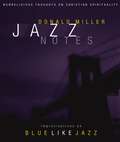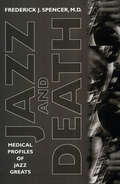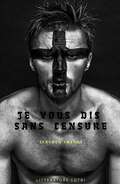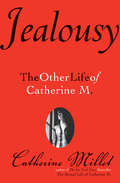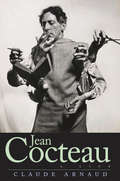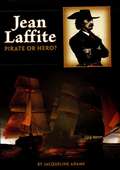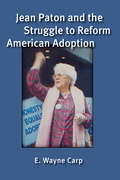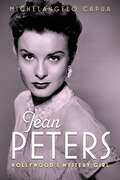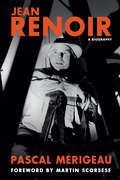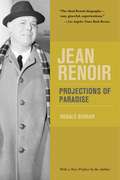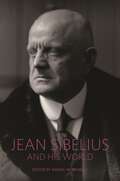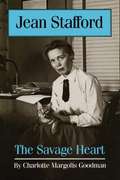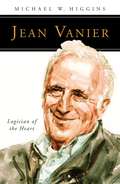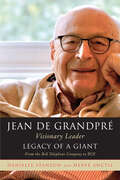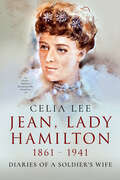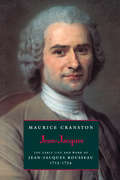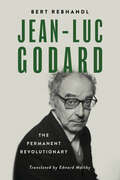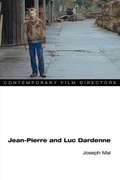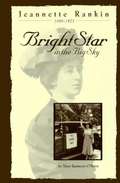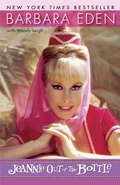- Table View
- List View
Jayshankar Prasad
by Ramesh Chandar ShahRamesh Chandra Shah has presented the biography of Jayshankar Prasad in this book and has presented the in-depth evaluation of his work. Shah presents Prasad as a writer whose writings are based on the foundation of psychological realism.
Jaywalking with the Irish
by David MonaganFrom the book: For David Monagan, born in Connecticut to a staunch Irish-American family, a lifelong interest in Ireland was perhaps inescapable. David studied literature at Dublin's Trinity College in 1973 and '74, and he became captivated by the country. After enjoying many visits in the intervening years, in 2000 David and his family relocated from the U.S. to Cork, Republic of Ireland. David has written for numerous publications, including the Irish Times, Sunday Independent, and Irish Examiner, and in his wide travels has developed a keen eye for things baffling and marvelous, such as he finds everywhere around him in modern-day Ireland.
Jazz Age Giant: Charles A. Stoneham and New York City Baseball in the Roaring Twenties
by Robert F. GarrattIn the early 1920s, when the New York Yankees&’ first dynasty was taking shape, they were outplayed by their local rival, the New York Giants. Led by manager John McGraw the Giants won four consecutive National League pennants and two World Series, both against the rival Yankees. Remarkably, the Giants succeeded despite a dysfunctional and unmanageable front office. And at the center of the turmoil was one of baseball&’s more improbable figures: club president Charles A. Stoneham, who had purchased the Giants for $1 million in 1919, the largest amount ever paid for an American sports team. Short, stout, and jowly, Charlie Stoneham embodied a Jazz Age stereotype—a business and sporting man by day, he led another life by night. He threw lavish parties, lived extravagantly, and was often chronicled in the city tabloids. Little is known about how he came to be one of the most successful investment brokers in what were known as &“bucket shops,&” a highly speculative and controversial branch of Wall Street. One thing about Stoneham is clear, however: at the close of World War I he was a wealthy man, with a net worth of more than $10 million. This wealth made it possible for him to purchase majority control of the Giants, one of the most successful franchises in Major League Baseball. Stoneham, an owner of racehorses, a friend to local politicians and Tammany Hall, a socialite and a man well placed in New York business and political circles, was also implicated in a number of business scandals and criminal activities. The Giants&’ principal owner had to contend with federal indictments, civil lawsuits, hostile fellow magnates, and troubles with booze, gambling, and women. But during his sixteen-year tenure as club president, the Giants achieved more success than the club had seen under any prior regime. In Jazz Age Giant Robert Garratt brings to life Stoneham&’s defining years leading the Giants in the Roaring Twenties. With its layers of mystery and notoriety, Stoneham&’s life epitomizes the high life and the changing mores of American culture during the 1920s, and the importance of sport, especially baseball, during the pivotal decade.
Jazz Notes: Improvisations on Blue Like Jazz
by Donald MillerJazz Notes is the literary equivalent of a remix CD-cool sound-bytes strategically crafted from Don Miller's classic Blue Like Jazz, combined with brand new material that offers the author's fans an inside look at some of the unforgettable-and outrageous-characters and stories from the original best seller. Jazz Notes captures the essential Don Miller with non-religious reflections on how Don's incredible spiritual odyssey got started; what happened to Don at one of the most liberal colleges in the world to help him experience faith and grace for the first time in his life; a recasting of Don's marvelous "confession booth" story; and how Don discovered the secret to really loving other people-and himself.
Jazz and Death: Medical Profiles of Jazz Greats
by Frederick J. SpencerWhen a jazz hero dies, rumors, speculation, gossip, and legend can muddle the real cause of death. In this book, Frederick J. Spencer, M.D., conducts an inquest on how jazz greats lived and died pursuing their art. Forensics, medical histories, death certificates, and biographies divulge the way many musical virtuosos really died. An essential reference source, Jazz and Death strives to correct misinformation and set the story straight. Reviewing the medical records of such jazz icons as Scott Joplin, James Reese Europe, Bennie Moten, Tommy Dorsey, Billie Holiday, Charlie Parker, Wardell Gray, and Ronnie Scott, the book spans decades, styles, and causes of death. Divided into disease categories, it covers such illnesses as ALS (Lou Gehrig's Disease), which killed Charlie Mingus, and tuberculosis, which caused the deaths of Chick Webb, Charlie Christian, Bubber Miley, Jimmy Blanton, and Fats Navarro. It notes the significance of dental disease in affecting a musician's embouchure and livelihood, as happened with Joe “King” Oliver. A discussion of Art Tatum's visual impairment leads to discoveries in the pathology of what blinded Lennie Tristano. Heavy drinking, even during Prohibition, was the norm in the clubs of New Orleans and Kansas City and in the ballrooms of Chicago and New York. Too often, the musical scene demanded that those who play jazz be “jazzed.” After World War II, as heroin addiction became the hallmark of revolution, talented bebop artists suffered long absences from the bandstand. Many did jail time, and others succumbed to the ravages of “horse.” With Jazz and Death, the causes behind the great jazz funerals may no longer be misconstrued. Its clinical and morbidly entertaining approach creates an invaluable compendium for jazz fans and scholars alike.
Je vous le raconte sans censure: Biographie érotique LGTB
by Alberto Aranda de la GalaUne biographie réelle où la réalité dépasse la fiction. Une histoire où le sexe se convertit en une recherche constante et où les expériences se multiplient et arrivent à dépasser la fiction de "50 Nuances de Grey". Un récit où l’homosexualité se montre telle quelle, crue, froide, mais vivante, chargée d’émotions. Un parcours au travers de l’Espagne, par le biais de l’histoire de la vie de son protagoniste, en recherche d’une réalité sexuelle définitive, comme jamais cela avait été raconté auparavant.
Jealousy: The Other Life of Catherine M. (Books That Changed the World)
by Catherine Millet&“A haunting story of fragile female identity, sexually gained, violently lost&” by the New York Times–bestselling author of The Sexual Life of Catherine M. (The New York Times Book Review). Catherine Millet&’s erotic memoir The Sexual Life of Catherine M. was a landmark book—a portrait of a sexual life lived without boundaries and without a safety net. Described as &“eloquent, graphic—and sometimes even poignant&” by Newsweek, and as &“[perhaps] one of the most erotic books ever written&” by Playboy, it drew international attention for its audacity and the apparently superhuman sangfroid required of Millet and her partner, Jacques Henric, with whom she had an extremely public and active open relationship. Now, Millet&’s follow-up answers the first book&’s implicit question: How did you avoid jealousy? &“I had love at home,&” Millet explains, &“I sought only pleasure in the world outside.&” But one day, she discovered a letter in their apartment that made it clear that Jacques was seriously involved with someone else. Jealousy details the crisis provoked by this discovery and Millet&’s attempts to reconcile her need for freedom and sexual liberation with the very real heartache caused by Jacques&’s infidelity. Jealousy delves into the world of emotion as evocatively as The Sexual Life of Catherine M. delves into the realm of the senses. Here is the paradoxical confession of a libertine who discovers that love, in any of its forms, can have a dark side. &“An honest, brutal piece of confession and self-analysis.&” —The Guardian
Jean Cocteau: A Life
by Claude ArnaudThis passionate and monumental biography reassesses the life and legacy of one of the most significant cultural figures of the twentieth century Unevenly respected, easily hated, almost always suspected of being inferior to his reputation, Jean Cocteau has often been thought of as a jack-of-all-trades, master of none. In this landmark biography, Claude Arnaud thoroughly contests this characterization, as he celebrates Cocteau's "fragile genius--a combination almost unlivable in art" but in his case so fertile. Arnaud narrates the life of this legendary French novelist, poet, playwright, director, filmmaker, and designer who, as a young man, pretended to be a sort of a god, but who died as a humble and exhausted craftsman. His moving and compassionate account examines the nature of Cocteau's chameleon-like genius, his romantic attachments, his controversial politics, and his intimate involvement with many of the century's leading artistic lights, including Picasso, Proust, Hemingway, Stravinsky, and Tennessee Williams. Already published to great critical acclaim in France, Arnaud's penetrating and deeply researched work reveals a uniquely gifted artist while offering a magnificent cultural history of the twentieth century.
Jean Laffite: Pirate or Hero? (Fountas & Pinnell LLI Purple #Level V)
by Jacqueline AdamsPirate, smuggler, outlaw, spy. Jean Laffite (ZHAHN la-FEET) was all of these things. But he was also a hero. This legendary pirate surprised everyone by defending the United States when it was under attack. This move came as a surprise because authorities from Louisiana, which was part of the United States, wanted to arrest Jean. Many stories are told about Jean Laffite. It's impossible to tell if some are true or exaggerated. But we do know some things about his unusual and adventurous life. Here is his story.
Jean Monnet and Canada
by Trygve UglandJean Monnet (1888-1979) is often viewed as the chief architect of the European Coal and Steel Community, which over time evolved into today's European Union. Monnet spent his early years working as an agent for his father, a cognac producer. It was this experience that took him to Scandinavia, England, the United States, and most importantly Canada, where he was exposed to the country's unique form of federalism.Drawing on a wide variety of empirical sources, including unpublished documents, correspondence, and original historical data extracted from archives both in Canada and Europe, Trygve Ugland's Jean Monnet and Canada argues that the extensive period of time Monnet spent in Canada between 1907 and 1914 had a formative influence on the achievements of his later years, particularly on the institutional 'construction of Europe.'
Jean Paton and the Struggle to Reform American Adoption
by E. Wayne CarpJean Paton (1908-2002) fought tirelessly to reform American adoption and to overcome prejudice against adult adoptees and women who give birth out of wedlock. Paton wrote widely and passionately about the adoption experience, corresponded with policymakers as well as individual adoptees, promoted the psychological well-being of adoptees, and facilitated reunions between adoptees and their birth parents. This masterful biography brings to light the accomplishments of this neglected civil-rights pioneer, who paved the way for the explosive emergence of the adoption reform movement in the 1970s. Her unflagging efforts over five decades helped reverse harmful policies, practices, and laws concerning adoption and closed records, struggles that continue to this day.
Jean Peters: Hollywood's Mystery Girl (Hollywood Legends Series)
by Michelangelo CapuaFrom 1947 to 1955, Jean Peters (1926–2000) appeared in films opposite such Hollywood leading men as Tyrone Power, Marlon Brando, Burt Lancaster, Spencer Tracy, Richard Widmark, and Robert Wagner, as well as international stars including Louis Jourdan and Rossano Brazzi. Despite her talent and status, Peters eschewed the star-studded lifestyle of 1950s Hollywood, turning down roles that were “too sexy” and refusing to socialize with other actors, discuss her private life in the press, or lead the glamorous lifestyle often associated with her peers. She was seen as a mystery to reporters, who constantly tried to discover tidbits about her personal life.In 1957, her marriage to Howard Hughes led to her retirement from acting and her further withdrawal from social events in Hollywood. Instead, she shifted her attention to charitable work, arts and crafts, and university studies in psychology and anthropology. Her status as an enigma only grew as she agreed never to speak of her marriage with Hughes. After her divorce, however, Peters attempted to resume her acting career in television but never regained her previous level of stardom. Jean Peters: Hollywood's Mystery Girl grants an in-depth analysis of each of her nineteen films and is enriched by several high-quality photographs from the author’s personal collection.
Jean Renoir: A Biography
by Martin Scorsese Bruce Benderson Pascal MerigeauOriginally published in France in 2012, Pascal Mérigeau's definitive biography of legendary film director Jean Renoir is a landmark work-the winner of a Prix Goncourt, France's top literary achievement. Now available in the English language for the first time, Jean Renoir: A Biography, is the definitive study of one of the most fascinating and creative artistic figures of the twentieth century.The life of the French filmmaker is divided between his native France and California, where he lived from 1941 until his death in 1979. Renoir was both an eyewitness and active player of his times: he was wounded in 1915 during World War I; became a director out of a love for film; attached his fortunes to the Communist Party in 1936; was hosted by Fascist Italy in 1940; and then went to Hollywood to make films and become an American citizen. He made movies in France, America, India, and Italy and became a writer during the last part of his life.An estimated 75 percent of the book details previously unknown information about the filmmaker, including:-Renoir's close affiliation with Communism in the '30s, when he was the Party's official director-His previously uncredited Hollywood film, The Amazing Mrs. Holiday-His desire to become an "American director” and appeal to American audiencesDrawing from unpublished or little-known sources and featuring previously unpublished photos, this biography is a completely fresh look at the maker of Grand Illusion and The Rules of the Game, redefining the very function of the movie director and recounting the history of a century.
Jean Renoir: Projections of Paradise
by Ronald BerganNow back in print, the definitive biography of a seminal figure in film history, whom Orson Welles called "the greatest of all directors. ” Jean Renoir’s career almost spans the history years of cinema-from the early silent movies, to the naturalism of the talkies, committed cinema, film noir, Hollywood studio productions, the Technicolor-period comedies and fast television techniques. His film The Grand Illusion remains one of the greatest movies about the effects of war. Decades after its release, Renoir’s The Rules of the Game (1939) is the only film to have been included on every top ten list in the Sight & Sound's respected decennial poll since 1952, cementing Renoir’s influence. André Bazin and François Truffaut praised Renoir as the patron saint of the French New Wave. Jean Renoir: Projections of Paradise gives detailed accounts of Renoir’s working methods and captivating appraisals of his films, and his long and fascinating life from his blissful childhood as the son of the great Impressionist painter August Renoir. This is a must-read for students of film and all fans of entertaining, timeless movies.
Jean Sibelius and His World (The Bard Music Festival #25)
by Daniel M. GrimleyNew perspectives on the greatest Finnish composer of all timePerhaps no twentieth-century composer has provoked a more varied reaction among the music-loving public than Jean Sibelius (1865–1957). Originally hailed as a new Beethoven by much of the Anglo-Saxon world, he was also widely disparaged by critics more receptive to newer trends in music. At the height of his popular appeal, he was revered as the embodiment of Finnish nationalism and the apostle of a new musical naturalism. Yet he seemingly chose that moment to stop composing altogether, despite living for three more decades. Providing wide cultural contexts, contesting received ideas about modernism, and interrogating notions of landscape and nature, Jean Sibelius and His World sheds new light on the critical position occupied by Sibelius in the Western musical tradition.The essays in the book explore such varied themes as the impact of Russian musical traditions on Sibelius, his compositional process, Sibelius and the theater, his understanding of music as a fluid and improvised creation, his critical reception in Great Britain and America, his "late style" in the incidental music for The Tempest, and the parallel contemporary careers of Sibelius and Richard Strauss.Documents include the draft of Sibelius's 1896 lecture on folk music, selections from a roman à clef about his student circle in Berlin at the turn of the century, Theodor Adorno's brief but controversial tirade against the composer, and the newspaper debates about the Sibelius monument unveiled in Helsinki a decade after the composer's death.The contributors are Byron Adams, Leon Botstein, Philip Ross Bullock, Glenda Dawn Goss, Daniel Grimley, Jeffrey Kallberg, Tomi Mäkelä, Sarah Menin, Max Paddison, and Timo Virtanen.
Jean Stafford: The Savage Heart
by Charlotte Margolis GoodmanOne of America's best short story writers and author of three fine novels,Boston Adventure (1944), The Mountain Lion (1947), and The Catherine Wheel (1952), Jean Stafford has been rediscovered by another generation of readers and scholars. Although her novels and her Pulitzer Prize-winning short stories were widely read in the 1940s and 1950s, her fiction has received less critical attention than that of other distinguished contemporary American women writers such as Carson McCullers, Flannery O'Connor, and Eudora Welty. In this literary biography, Charlotte M. Goodman traces the life of the brilliant yet troubled Jean Stafford and reassesses her importance. Drawing on a wealth of original material, Goodman describes the vital connections between Stafford's life and her fiction. She discusses Stafford's difficult family relationships, her tempestuous first marriage to the poet Robert Lowell, her unresolved conflicts about gender roles, her alcoholism and bouts with depression-and her amazing ability to transform the chaotic details of her life into elegant works of fiction. These wonderfully crafted works offer insightful portraits of alienated and isolated characters, most of whom exemplify not only human estrangement in the modern world, but also the special difficulties of girls and women who refuse to play traditional roles. Goodman locates Jean Stafford within the literary world of the 1940s and 1950s. In her own right, and through her marriages to Robert Lowell, Life magazine editor Oliver Jensen, and journalist A. J. Liebling, Stafford associated with many of the major literary figures of her day, including the Southern Fugitives, the New York intellectual coterie, and writers for the New Yorker, to whichshe regularly contributed short stories. Goodman also describes Stafford's sustaining friendships with other women writers, such as Evelyn Scott and Caroline Gordon, and with her New Yorker editor, Katharine S. White. This highly readable biography will appeal to a wide audience interested in twentieth-century literature and the writing of women's lives.
Jean Vanier: Logician of the Heart (People of God)
by Michael HigginsJean Vanier, Winner of the 2015 Templeton Prize and numerous other international and prestigious honors, Jean Vanier lives a radical poverty of surrender in a time of fanatical acquisitiveness, economic disparity, and mounting bellicosity among nations. He is a philosopher of the heart, icon of wholeness, and justice activist. Through such key notions as trust, community, relationship, and humility, Vanier has built up a network of service and nurturing growth spanning the globe: the L'Arche Movement. He has advocated for peace in a world that treasures its violence, written extensively about the very meaning of human personhood, and championed sensitivity to the diverse spiritual traditions that make up our world. His remarkable life has included rich friendships with Blessed Mother Teresa, St. John Paul II and Henri Nouwen. Jean Vanier is a man of complexity and formal philosophical training, a scion of a family of national pedigree, and one of the seminal religious and inspirational figures of our time. In this volume, Michael Higgins focuses on Vanier’s many interconnections—personal and conceptual—with the mighty and the humble, the pious and the secular, as well as the young and the seasoned.
Jean de Grandpré: Legacy of a Giant
by Danielle Stanton Hervé AnctilVisionary leader and businessman Jean de Grandpré has earned many nicknames: he is known variously as the Simplifier, the Architect, and the Strategist. A lawyer when he joined Bell Canada in 1966, he went on to build a telecommunications empire that spanned the continent, crossing paths with politicians, moguls, and philanthropists along the way.Beginning as Bell’s general counsel, de Grandpré quickly rose through the corporate ranks and became president in 1973. A few years later he created Bell Canada Enterprises, one of America’s largest telecommunications companies. A globally recognized manager and director, he has served on the boards of numerous companies, both in Canada and abroad. As generous as he is discreet, he is involved with several charities, including the Papillon Foundation, which helps disabled children. At McGill University, his alma mater, De Grandpré served as chancellor from 1984 to 1991 and is now governor emeritus and chancellor emeritus.Danielle Stanton and Hervé Anctil retrace the admirable career of this influential man whose life has spanned a century. Offering insight into the secrets of his success, Jean de Grandpré will inspire new generations of entrepreneurs.
Jean, Lady Hamilton, 1861–1941: Diaries of A Soldier's Wife
by Celia Lee“A pleasure to read. It’s predominantly about the life of Jean Hamilton’s husband Ian as an officer during the Great War and life for both before and after.” —UK HistorianJean, Lady Hamilton’s diaries remained forgotten and hidden in the Liddell Hart Centre for Military Archives, King’s College, London, for fifty years. The story begins with the young couples’ wedding, a dazzling bride, Jean Muir, marrying a star-struck Major Ian Hamilton. The daughter of the millionaire businessman Sir John Muir, Jean had all the money whilst Hamilton was penniless.Having spent their early married years in India, the Hamiltons returned and set up house in the prestigious Hyde Park area of London, also eventually buying Lullenden Manor, East Grinstead, that they purchased as a country home from Winston Churchill when he could no longer afford it. Churchill in particular was like family in the Hamiltons’ home; he used to go there and practice his speeches, and painted alongside Jean to whom he sold his first painting.Jean chronicled Ian’s long army career that culminated in the Gallipoli campaign in 1915. The failure there ended her husband’s distinguished career and almost ended Churchill’s as he had to leave his job as First Lord of the Admiralty. This account is Lady Hamilton’s “attempt to chronicle her husband’s life as a top-flight but penniless soldier, this at a time when young Winston Churchill . . . was emerging from his own distinguished and very colourful military career to enter a life of politics . . . Jean Hamilton is one of those larger than life people of whom we know very little until a book such as Celia’s comes along” (Books Monthly).
Jean-Jacques: The Early Life And Work Of Jean-Jacques Rousseau, 1712-1754
by Maurice CranstonIn recent years Rousseau has returned to public favour. Before the war he was commonly regarded as an evil genius, a prophet at once of fascism and of communism, an enemy of reason and science, responsible both for the romantic revival and the French Revolution, a mountebank, a psychotic and a freak.
Jean-Luc Godard: The Permanent Revolutionary (Wisconsin Film Studies)
by Bert RebhandlIn this biography, now translated into English for the first time, Bert Rebhandl provides a balanced evaluation of the work of one of the most original and influential film directors of all time: Jean-Luc Godard (1930–2022). In this sympathetic yet critical overview, he argues that Godard's work captured the revolutionary spirit of Paris in the late 1960s as no other filmmaker has dared, and in fact reinvented the medium. Rebhandl skillfully weaves together biographical details; information about the cultural, intellectual, and cinematic milieu over the decades; and descriptions of Godard’s most significant films to support his assertion that the director was a permanent revolutionary—always seeking new ways to create, understand, and comment on film within a larger context. He views Godard as an artist consistently true to himself while never ceasing to change and evolve, often in unexpected, radical, and controversial ways. Rebhandl is known as a journalist with deep insights and lucid prose. Despite the wealth of material to analyze, he neither gets lost in the details nor offers a superficial gloss, even while directly tackling such topics as the long-standing charges of antisemitism against Godard and his oeuvre. This volume will be welcome to both casual fans and dedicated devotees.
Jean-Pierre and Luc Dardenne (Contemporary Film Directors)
by Joseph MaiFor well over a decade, Jean-Pierre and Luc Dardenne have produced highly original and ethically charged films that immerse their audiences in an intense and embodied viewing experience. Their work has consistently attracted international recognition, including the rare feat of two Palmes d'Or at Cannes. In this first book-length study of the Belgian brothers, Joseph Mai delivers sophisticated close analyses of their directorial style and explores the many philosophical issues dealt with in their films (especially the ethics of Emmanuel Levinas). Mai discusses the Dardennes' varied and searching career from its inception in the late 1970s, starting with the working-class political consciousness and lost utopias of their documentary period; passing through their transition toward fictional narrative, experimental techniques, and familial themes; and finishing with a series of in-depth and philosophically informed interpretations of the brothers' more recent work. In such highly influential films such as La promesse, Rosetta, The Son, and The Child, the brothers have recast filmmaking through what Mai calls a "sensuous realism"--realism capable of touching the audience with the most compelling problems and moral dilemmas of contemporary society. This volume also features an interview in which the Dardennes discuss their approach to film production and the direction of actors.
Jeannette Rankin: Bright Star in the Big Sky
by Mary Barmeyer O'BrienThis book chronicles the extraordinary life of Jeanette Rankin. The first woman ever elected to the U.S. Congress, Jeannette represented Montana for two terms in the U.S. House of Representatives. She was a leading advocate for both woman suffrage and world peace and was instrumented in securing the right for Montana women to vote. As the sole female member of the U.S. Congress in 1919, Jeanette was the only woman who voted to give all women in the United States the right to vote. After readers witness the vote that made Ms. Rankin most famous-her lone vote against U.S. entry into World War II-they turn to her youngest years in Missoula, Montana. The book continues to follow Jeannette's life from beginning to end, exposing her many courageous and remarkable accomplishments. Jeannette once said: "Wouldn't it be too bad if we left this world and hadn't done all we could for peace?" She herself had nothing to regret. Readers will be inspired by this magnificent portrait of her life.
Jeannie Out of the Bottle
by Wendy Leigh Barbara EdenA magical, heartwarming memoir from one of Hollywood's most beloved icons Over the past four decades, the landmark NBC hit television series I Dream of Jeannie has delighted generations of audiences and inspired untold numbers of teenage crushes on its beautiful blond star, Barbara Eden. Part pristine Hollywood princess and part classic bombshell, with innocence, strength, and comedic talent to spare, Barbara finally lets Jeannie out of her bottle to tell her whole story. Jeannie Out of the Bottle takes us behind the scenes of I Dream of Jeannie as well as Barbara's dozens of other stage, movie, television, and live concert performances. We follow her from the hungry years when she was a struggling studio contract player at 20th Century Fox through difficult weeks trying to survive as a chorus girl at Ciro's Sunset Strip supper club, from a stint as Johnny Carson's sidekick on live TV to tangling on-screen and off with some of Hollywood's most desirable leading men, including Elvis Presley, Clint Eastwood, Paul Newman, and Warren Beatty. From the ups and downs of her relationship with her Jeannie co-star Larry Hagman to a touching meeting with an exquisite and vulnerable Marilyn Monroe at the twilight of her career, readers join Barbara on a thrilling journey through her five decades in Hollywood. But Barbara's story is also an intimate and honest memoir of personal tragedy: a stillborn child with her first husband, Michael Ansara; a verbally abusive, drug-addicted second husband; the loss of her beloved mother; and the accidental heroin-induced death of her adult son, just months before his wedding. With candor and poignancy, Barbara reflects on the challenges she has faced, as well as the joys she has experienced and how she has maintained her humor, optimism, and inimitable Jeannie magic throughout the roller-coaster ride of a truly memorable life. Illustrated with sixteen pages of photographs, including candid family pictures and rare publicity stills, Jeannie Out of the Bottle is a must-have for every fan, old and new.From the Hardcover edition.

